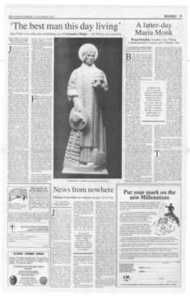Page 10, 5th November 1999
Page 10

Report an error
Noticed an error on this page?If you've noticed an error in this article please click here to report it.
Tags
Share
Related articles
Doubts 2 . Queries Ul
Doubts
Doubts
Doubts
Doubts
Doubts 2_ Queries UL
Father Richard Barrett answers readers' questions
Why is the sacrament of marriage valid only for this life?
TaE READER must be referring to the encounter between Jesus nd the Sadducees, when Jesus makes the statement that "when people rise from the dead they are neither given nor taken in marriage but are as the angels in heaven" (Mk 12:247). This statement ofJesus's may be interpreted to mean several things. To begin with it may simply mean that there are no spiritual weddings in heaven because the rationale for marriage is no longer present. In another interpretation, maniage survives death but as a relationship between spouses that is dominated by the primary relation
ship to God. The statement of Jesus may also mean, however, that there is no enduring marriage bond in heaven so that the individuals who were once spouses on earth are so caught up with love for God that their former relationship is lost in the new situation.
We need to keep at the forefront of our minds the theological and relational purpose of marriage; namely the need to establish a productive love, a physical communion of life and the need for procreativity (as outlined in Gaudium et Spes 48a, Humanae 14tae 9 and Familiaris Consortio 11). Marriage responds to a divine design for the happiness of human beings (Homosexualitatis Problema 7) for, according to Augustine, God himself is the author of marriage (De Bono Coniugali 40, 375-6, 394).
In the union of marriage, man and woman "are no longer two but one" (Mt 19:6) and their relationship will assist them in their personal progress in the spiritual life (S Thomas Aquinas ST Suppl q 49, art 3 ad 1). A
comparison is suggested in the love of God for Israel (Hosea 2:4, 10, 18) and in the presence of Christ to the married partners (Mt 9:15; Mk 2:19-20; Lk 5:3435; II Cor 11:2; Eph 5:27; Apoc 19:7-8). The comparison with a pact of love and fidelity from the scriptures might lead us to assume that something of the marriage relationship survives death and is taken up and perfected in heaven. This walla be a reasonable conclusion. Authentic conjugal love, after all, is assumed in divine love and is sustained and enriched by the redemptive power of Christ and the salvific action of the Church, and this all the more so when the spouses undertake the mission of father and mother and produce a Christian family (Gaudium et Spes 48b). Conjugal love and responsible parenthood, then, are the twin realities that energise the marriage commitment and give it concreteness that is expressed in lifelong fidelity.
The next life, however, as John Paul 11 has been reminding us of late, is dominated by other considerations. These chiefly focus on the fact that for the blessed the next life is a union with God first and a reunion with those they have known and loved second. They are as angels because they will contemplate the glory of God and be responsive to the promptings of the Holy Spirit. In this way there will simply be no room for a relationship that is exclusive and geared to sex and the procreation of children.
Why cannot priests many? Is it just a question of Church law?
1-14E READER has plumped for one of the great chestnuts of our time. It has to be said that the promise of celibacy is a matter of Church law, but that Church laws sometimes have greater roots in tradition and greater theological rationales than we can imagine. Celibacy is a case in point.
In the Sixties and Seventies it was simply assumed that celibacy began around the 13th century with the Council Lateran IV (1215), which prohibited clandestine marriages for the clergy. It was assumed that celibacy was designed chiefly as a way of preserving the property of the Church (DS 817). The advantage of celibacy was that a marriageless clergy would have no dependents to cater for and no descendants to provide for in their wills. This view of the matter held sway over many clerics and scholars throughout the period during and immediately following the Second Vatican Council (1963-65).
In the Eighties, however, a scholarly book appeared which turned this view on its head and argued persuasively that the law of celibacy (no marriage) was a law of continence (no sex) and that it went back to apostolic times, notwithstanding the fact that many clerics married (Christian Cochini, The Apostolic Origins of Priestly Celibacy, San Francisco, Ignatius Press 1988).
The law of continence was a law that prohibited the conception of children in clerical marriages and prescribed a vow of abstinence from sex for the couple after the ordination of the male. Certainly in the tradition the evidence is there. Bishops, priest and deacons were reduced or deposed if they conceived children after ordination. In fact, today, the 1983 Code of Canon Law prefers to speak of the "law of continence" in the canon which deals with this matter for clerics (can 277 § 1). The canon uses the two terms interchangeably but they are quite distinct in popular theology.
The expositive part of the canon states that "celibacy is a special gift of God by which sacred ministers can more easily remain close to Christ with an undivided heart, and can dedicate themselves more freely to the service of God and their neighbour". There is, then, a theological reason (closeness to Christ) and a practical reason (freedom to serve) for the current discipline of celibacy. It is wise, however; to keep the two ideas of celibacy and continence distinct from one another.
The equivalent canon in the Eastern code states the fact that in the East another discipline operates. Canon 373 (CCEO) remarks: "Clerical celibacy chosen for the sake of the kingdom of heaven and suited to the priesthood is to be greatly esteemed everywhere, as supported by the tradition of the whole Church; likewise the hallowed practice of married clerics in the primitive Church in the tradition of the Eastern Churches throughout the ages is to be held in honour."
The terminology of the canon is significant, for celibacy is described as a "tradition" while clerical marriage is simply described as a "practice". At the end of the day, the principal theological rationale for celibacy is situated in the example of Christ, who did not many. This is the real chestnut
blog comments powered by Disqus













